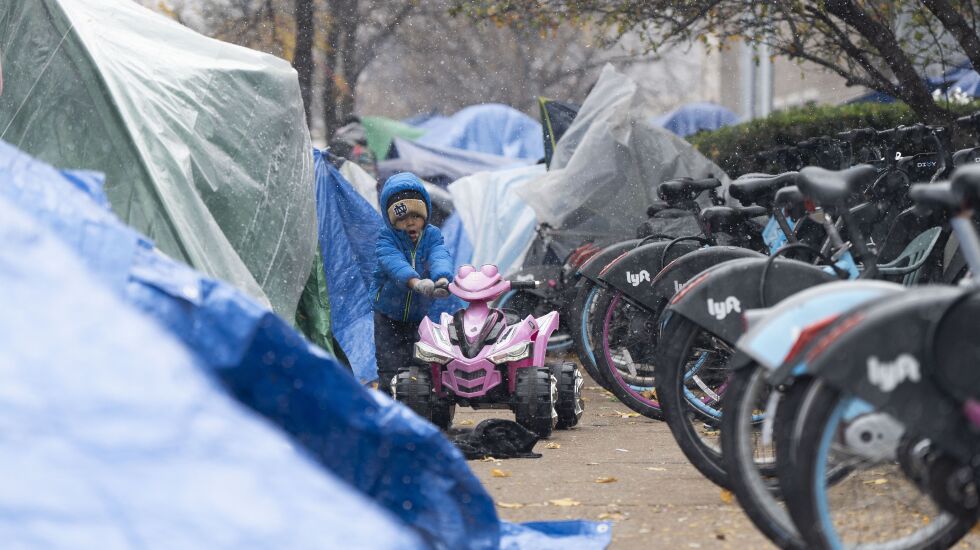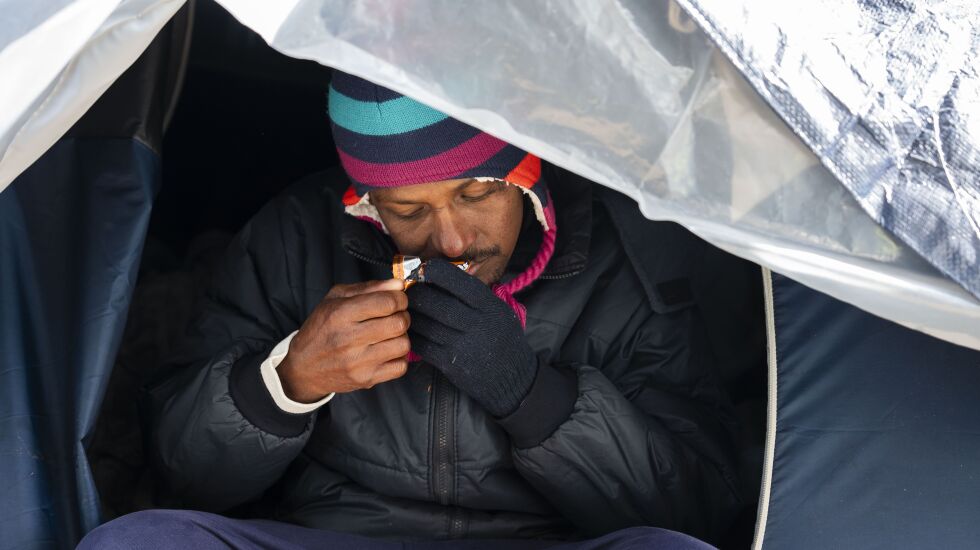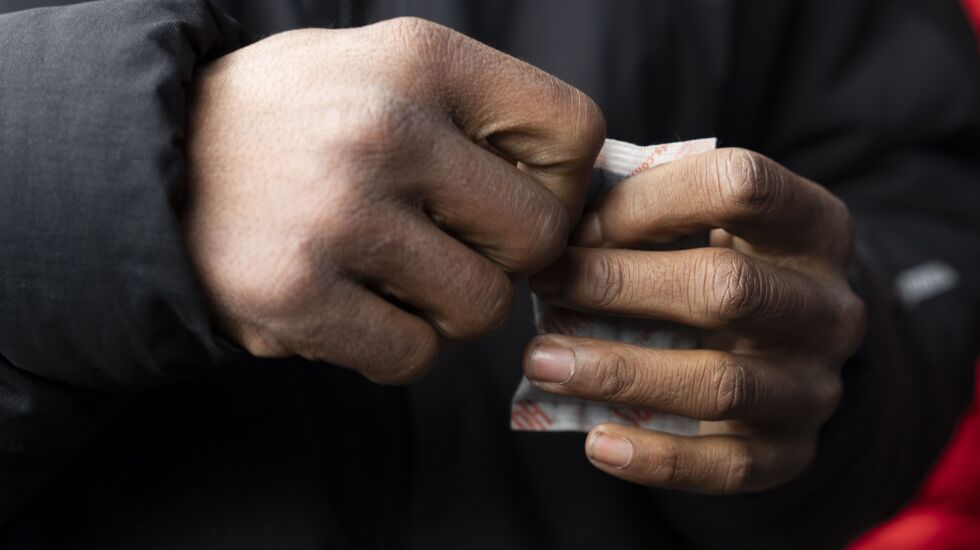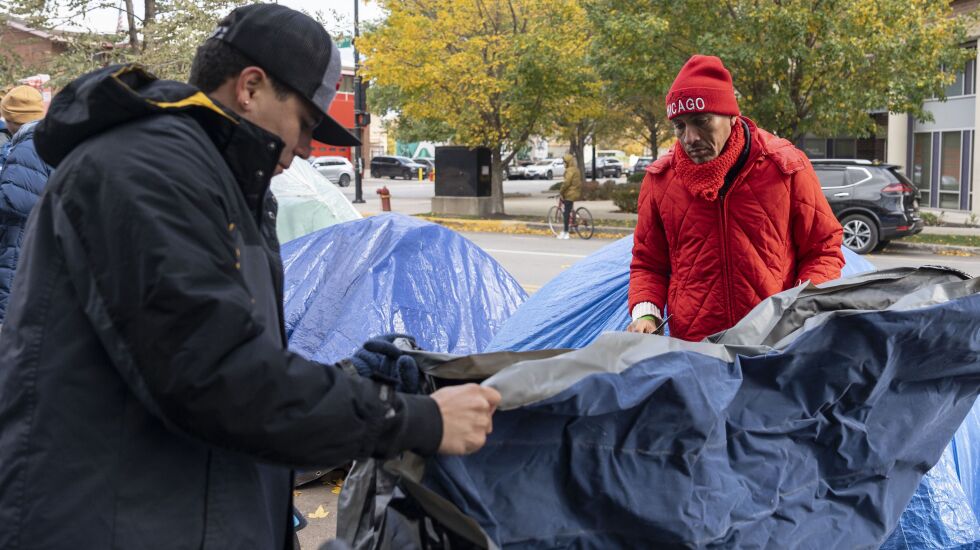
Freddy Ortiz, a migrant from Valencia, a Venezuelan city near the Caribbean coast, saw snow for the first time Tuesday, a novel and — for the 43-year-old with no way to shelter — unwelcome experience.
“It’s very pretty,” said Ortiz, from his tent set up outside the Near North District police station, “but it’s so cold it hurts.”
Thousands of migrants, like Ortiz, are staying at Chicago Police district stations waiting for room in city shelters to open up. Many have found some respite in donations from passersby and city warming buses, but as the city gets its first snow of the season, all that isn’t enough to stave off the cold.
“The cold was tremendous,” said Ortiz of the low temps the night before. “It doesn’t let you sleep.”
The problem, he said, was that he’s staying outside in a tent “that’s not meant for this.”

Like dozens at that station and others, Ortiz has been spending his nights in a recreational tent donated by volunteers and better suited for dry summer nights.
Nearly 3,000 migrants were sleeping unhoused at police stations Tuesday, according to the Office of Emergency Management and Communications, waiting for space at any of the city’s nearly 25 shelters to open up.
Of that number, advocates estimate more than 1,000 or more are sleeping outdoors because there isn’t room inside stations.
Linda Bello and José Urribarri, parents of a young girl and boy, said they are able to sleep inside the Near North station overnight, but the new problem is it’s so cold now that staying outside the rest of the day is becoming unbearable.
Migrants at the station, like several others, aren’t allowed inside during the day. Police officials directed any comments about that policy to the mayor’s office.
A spokesperson for the city said the issue of migrants not being allowed inside at the Grand Crossing and Calumet District police stations, where the problem had been reported on social media, was due to “miscommunication.”
At the Near North station, migrants were still convinced they weren’t allowed inside during the day.
Spending their days outside in the cold, Bello and Urribarri are especially fearful for what will come of their 3-year-old boy, who had to go to the hospital with illness shortly after their arrival in Chicago on Oct. 7.
Bello, 29, said the boy, José Leonardo, was given a course of antibiotics and his condition improved briefly, but as the weather has turned, his illness appears to be returning.
“For two weeks, he’s had phlegm and a cough,” said Urribarri, 45. “He’s starting to get feverish, and now with the cold, I don’t know.”
The family is from Falcon, Venezuela, a coastal region close to Aruba known for “the best beaches in Venezuela.” Urribarri worked on a boat for tourists, but they left after the industry dried up.
They were sent to Chicago on a bus from Laredo, Texas, where they said workers at a church told them “they had to go” and were given a choice between New York and Chicago.
They chose Chicago and take comfort in their faith that “God sent [them] here for a reason,” Urribarri said, but seeing snow for the first time in their lives is making them feel “hopeless.”

The number of migrants at stations ballooned over the summer when the pace of arrivals accelerated in late May, after Mayor Brandon Johnson was sworn in and the city was awarded the 2024 Democratic National Convention.
The city has opened up a bevy of shelters since then — up from 15 at the start of August — but not enough to keep pace with the rate of arrivals.
In July, 1,000 people arrived, 1,500 in August and 3,500 in September. The rate slowed somewhat for October, down to around 3,000, after an initial spike in the number of buses arriving at the start of the month.
Space in the city’s current shelters has been hard to come by as the pace of the state’s rental assistance program for asylum-seekers seems too slow. Catholic Charities, the leading provider of the program, has been increasing their rate of resettlement, but their ability to find willing landlords and move people in are factors in how quickly families are placed.
Sally Blount, president and CEO of Catholic Charities of the Archdiocese of Chicago, attributed their gains to looking beyond Chicago for housing and to the help of partners, such as New Life Centers, for help with move-ins.
In the meantime, the city announced Tuesday evening it would send warming buses to all stations housing migrants and called for donations of warm clothing or funds to purchase appropriate clothing.
A spokesperson for the city’s Department of Emergency Management and Communications said the city was sending buses from 8 p.m. to 8 a.m., plus passing out coats at stations and to migrants arriving on buses.
For the newest arrivals at the station, those who have been there longest have become the point person and have stocked up supplies of their own.

Outside the tent where he’s been staying for since Oct. 6, Jojan Alfredo Piñero-Manzo, a former firefighter from Caracas, Venezuela, has stockpiled boots, jackets and even food into neat bags, baskets and piles for new arrivals.
“Just in case,” the 40-year-old said as he picked up a carton full of frigid-looking hotdogs, “sometimes they don’t come with food,” referring to volunteers who provide meals.
Piñero’s tent looks directly onto a Target, where he imagines he could buy a heater for his tent potentially, but he said he wouldn’t have the power anyway.
Migrants outside the station have power cords running through the camp that many were using to charge their phones, but officers at the station pulled that cord the night before.
A city spokesperson said they weren’t providing heaters for “safety reasons.”

The solution, as Piñero-Manzo sees it, would be to find work, and he even went to the fire station across the street to find out if he could get a job there but learned it wasn’t so simple.
He laughs at the irony of being so close yet so far. “I have to start from zero,” he said.
For now, he’s planning to keep adding to his stockpile for newcomers and plans on “rolling up in several blankets and extra clothes” for the night.
Michael Loria is a staff reporter for the Chicago Sun-Times via Report for America, a not-for-profit journalism program that aims to bolster the paper’s coverage of communities on the South Side and West Side.







